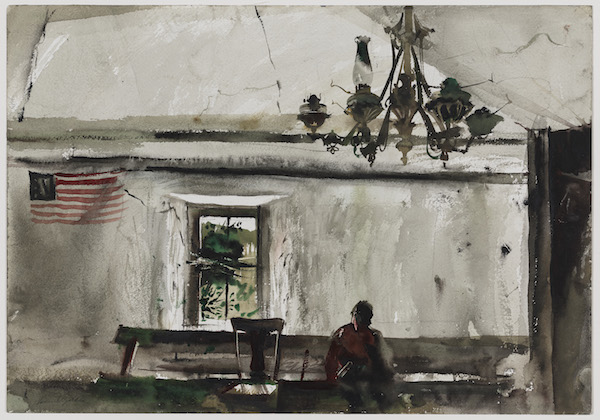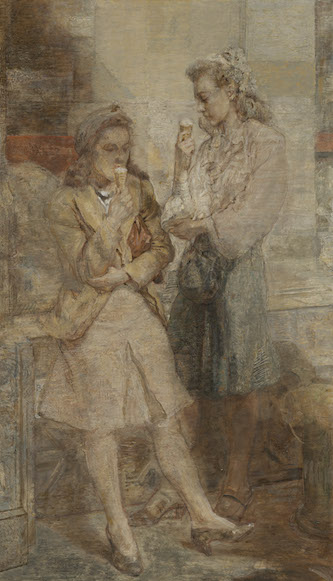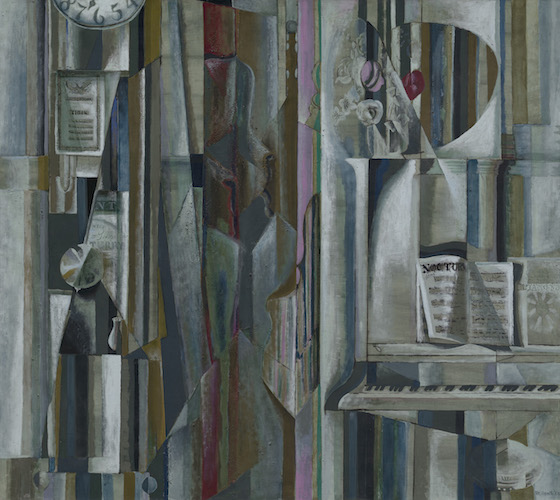Visual Arts Review: “Collecting Stories” — Yarns Worth Viewing
By Kathleen Stone
Almost every painting here is a discovery worth making.
Collecting Stories: A Mid-Century Experiment, Museum of Fine Arts Boston, Bernard and Barbara Stern Shapiro Gallery (Gallery 231), through March 8, 2020.

“Memorial Day,” Andrew Wyeth. Photo: Museum of Fine Arts, Boston.
Here’s a thought experiment: your mission is to build a collection of contemporary art, made by up-and-coming artists. Whose work do you buy? What criteria do you use? How will the public react? And peering ahead, what will generations not yet born think?
Actually, this is more than a thought experiment. It happened at Boston’s Museum of Fine Arts. Over the sixteen year span between Pearl Harbor and Sputnik, curators built a collection of emerging artists’ work. For decades it has been in storage but now, in show entitled Collecting Stories: a Mid-Century Experiment, the public can judge for themselves how well the curators did.
When we evaluate art, with or without hindsight, it is tempting to rely on market value as a yardstick. If that were the only test for art of the ’40s and ’50s, Abstract Expressionism would be even more dominant than it already is. But market value alone can overlook artistic experimentation and synthesis, social context and individual thought. The MFA’s exhibit pays attention to those criteria and makes clear that artists at the time were working across a broad range of artistic concerns.
Some of the names are familiar, like Andrew Wyeth and Marsden Hartley, but most are not. Does the fact that most of the names here are obscure suggest that the curators chose unwisely? I say no. While different in style and subject matter, almost every painting in the room is a discovery worth making.
Take the Andrew Wyeth, for instance. His Memorial Day (1946) is a small watercolor of an individual sitting in a church pew. The walls are white washed and unadorned, and an American flag hangs in one corner. Given the title and the date, it’s easy to imagine the person in the pew paying tribute to war dead. Then again, Wyeth lost his own father only months earlier, when a train struck his car. The style here is looser than Wyeth’s customary approach; it conveys the raw poignancy of his own emotional state.
Other works evoke the Great Depression. Aaron Bohrod, a name new to me, painted Oak Street Platform (1940) with a lone woman on a train platform. Faded building facades and empty tracks that stretch into the distance evoke a sense of isolation reminiscent of Edward Hopper. Aimée Lamb’s Waiting (1941) also focuses on separation, depicting two faceless men, also next to empty train tracks. These paintings date from the end of the Depression; works that date from just a few years earlier are even more explicit in their depiction of social dislocation. In Mervin Jules’s Banquet (1936) an emaciated man fishes in a garbage can for his dinner. Portrait of an Old Man (1939) by Joseph Hirsch shown a man’s elongated figure, shabbily dressed and with hat in hand.

“Ice Cream Cones,” Isabel Bishop. Photo: Museum of Fine Arts, Boston
Perhaps counterintuitively, once the war began, a new optimism appeared in art. In Ice Cream Cones (1942), Isabel Bishop shows two young women enjoying their dessert on a warm afternoon. They’re dressed in stylish office clothes, members of the large cohort of women who, in the ’40s, enjoyed the rewards of salaried work.
Other artists engaged with cubism, expressionism, and surrealism, even fantasy. In Harold Sterner’s Beach Scene With a Newspaper (1941), a woman reads at the beach. Her bathing suit, hair wrap, newspaper, and the roller coaster in the distance look like a Mobius strip — they are all stark white. The picture resonates with the surrealist art of Giorgio de Chirico. Fannie Louise Hillsmith’s work is even more indebted to cubism. She exhibited at Peggy Guggenheim’s New York gallery, notable because Guggenheim usually favored more abstract and surrealistic art. (She gave Jackson Pollock his first solo exhibition.) Hillsmith’s Nocturne (1954) is not as revolutionary as Pollock’s work. It seems related to Juan Gris and other early cubists, though it a worthy part of that lineage.
This was a “provisional” collection. In museum-speak, that means the curators could sidestep the cumbersome process of formal acquisition. Later, they could sell the work, also without jumping through too many hoops. Fortunately, the museum held on to these paintings. Though the selection comes from a narrow span of time, they serve as acute reminders of an America that now is gone. It also reflects a time that acquiring art was, at least potentially, a far more democratic process.
After the Depression, America supported its artists through the WPA. In 1952, for instance, the Colorado Springs Art Museum staged an exhibition of works recently acquired by museums across the country; at least one of Boston’s paintings traveled there. Popular magazines like Life carried articles about emerging artists, and Fortune put quality art work on its covers. Publisher Henry Luce encouraged his readers to know about American art. He also wanted the twentieth century to be known as the ‘American Century.’ In his February 1941 editorial for Time he called for a robust internationalism, with America at its center, promoting freedom and democracy around the world. His vision is a stark contrast to the prevailing view today.
It is worth noting that the Henry Luce Foundation has underwritten this exhibit. The museum staff includes Zoë Samels, curatorial research associate, and a team of designers and interpretation experts.

“Nocturne,” Fannie Louise Hillsmith. Photo: Museum of Fine Arts, Boston
The process of acquiring art has now radically changed. In the ’40s and ’50s, aside from the comparatively big ticket items produced by Abstract Expressionism, there was plenty of reasonably priced art. Many small galleries were eager to show new work to middle class aficionados. A sign of how the times have changed: just recently, $91 million was paid for a metallic rabbit. Robert Mnuchin, father of Steve, Secretary of the Treasury, was the purchaser. Commentators have pointed out that, while the rabbit’s price set a record, the exchange was representative of the hyper-inflated prices that only the super-wealthy can pay. The middle class — even the one percent — can’t keep up with the inflation. Nor can smaller galleries. The market for contemporary art that once welcomed everyone seems to have become a game that only the wealthiest (oligarchs of all countries, etc) can play.
Back to the thought experiment. You are the curator buying today’s art. What values will your choices reflect? How does this mid-century experiment from sixty years ago inform your decisions? How will you know if you got it right?
Kathleen Stone lives in Boston and writes critical reviews for The Arts Fuse. She co-hosts a literary salon known as Booklab and is at work on several long projects. She holds graduate degrees from the Bennington Writing Seminars and Boston University School of Law, and her website can be found here.
Tagged: Collecting Stories: a Mid-Century Experiment, Kathleen Stone
